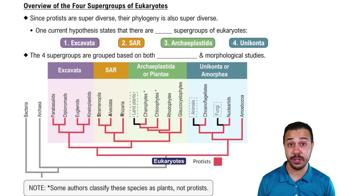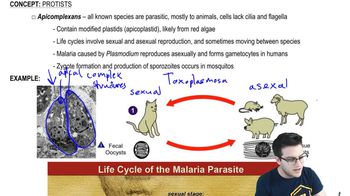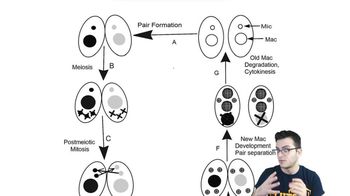Table of contents
- 1. Introduction to Biology2h 42m
- 2. Chemistry3h 40m
- 3. Water1h 26m
- 4. Biomolecules2h 23m
- 5. Cell Components2h 26m
- 6. The Membrane2h 31m
- 7. Energy and Metabolism2h 0m
- 8. Respiration2h 40m
- 9. Photosynthesis2h 49m
- 10. Cell Signaling59m
- 11. Cell Division2h 47m
- 12. Meiosis2h 0m
- 13. Mendelian Genetics4h 44m
- Introduction to Mendel's Experiments7m
- Genotype vs. Phenotype17m
- Punnett Squares13m
- Mendel's Experiments26m
- Mendel's Laws18m
- Monohybrid Crosses19m
- Test Crosses14m
- Dihybrid Crosses20m
- Punnett Square Probability26m
- Incomplete Dominance vs. Codominance20m
- Epistasis7m
- Non-Mendelian Genetics12m
- Pedigrees6m
- Autosomal Inheritance21m
- Sex-Linked Inheritance43m
- X-Inactivation9m
- 14. DNA Synthesis2h 27m
- 15. Gene Expression3h 20m
- 16. Regulation of Expression3h 31m
- Introduction to Regulation of Gene Expression13m
- Prokaryotic Gene Regulation via Operons27m
- The Lac Operon21m
- Glucose's Impact on Lac Operon25m
- The Trp Operon20m
- Review of the Lac Operon & Trp Operon11m
- Introduction to Eukaryotic Gene Regulation9m
- Eukaryotic Chromatin Modifications16m
- Eukaryotic Transcriptional Control22m
- Eukaryotic Post-Transcriptional Regulation28m
- Eukaryotic Post-Translational Regulation13m
- 17. Viruses37m
- 18. Biotechnology2h 58m
- 19. Genomics17m
- 20. Development1h 5m
- 21. Evolution3h 1m
- 22. Evolution of Populations3h 52m
- 23. Speciation1h 37m
- 24. History of Life on Earth2h 6m
- 25. Phylogeny2h 31m
- 26. Prokaryotes4h 59m
- 27. Protists1h 12m
- 28. Plants1h 22m
- 29. Fungi36m
- 30. Overview of Animals34m
- 31. Invertebrates1h 2m
- 32. Vertebrates50m
- 33. Plant Anatomy1h 3m
- 34. Vascular Plant Transport1h 2m
- 35. Soil37m
- 36. Plant Reproduction47m
- 37. Plant Sensation and Response1h 9m
- 38. Animal Form and Function1h 19m
- 39. Digestive System1h 10m
- 40. Circulatory System1h 57m
- 41. Immune System1h 12m
- 42. Osmoregulation and Excretion50m
- 43. Endocrine System1h 4m
- 44. Animal Reproduction1h 2m
- 45. Nervous System1h 55m
- 46. Sensory Systems46m
- 47. Muscle Systems23m
- 48. Ecology3h 11m
- Introduction to Ecology20m
- Biogeography14m
- Earth's Climate Patterns50m
- Introduction to Terrestrial Biomes10m
- Terrestrial Biomes: Near Equator13m
- Terrestrial Biomes: Temperate Regions10m
- Terrestrial Biomes: Northern Regions15m
- Introduction to Aquatic Biomes27m
- Freshwater Aquatic Biomes14m
- Marine Aquatic Biomes13m
- 49. Animal Behavior28m
- 50. Population Ecology3h 41m
- Introduction to Population Ecology28m
- Population Sampling Methods23m
- Life History12m
- Population Demography17m
- Factors Limiting Population Growth14m
- Introduction to Population Growth Models22m
- Linear Population Growth6m
- Exponential Population Growth29m
- Logistic Population Growth32m
- r/K Selection10m
- The Human Population22m
- 51. Community Ecology2h 46m
- Introduction to Community Ecology2m
- Introduction to Community Interactions9m
- Community Interactions: Competition (-/-)38m
- Community Interactions: Exploitation (+/-)23m
- Community Interactions: Mutualism (+/+) & Commensalism (+/0)9m
- Community Structure35m
- Community Dynamics26m
- Geographic Impact on Communities21m
- 52. Ecosystems2h 36m
- 53. Conservation Biology24m
27. Protists
Eukaryotic Supergroups: Exploring Protist Diversity
Problem 6`
Textbook Question
Based on the phylogenetic tree in Figure 28.2, which of the following statements is correct?
a. The most recent common ancestor of Excavata is older than that of SAR.
b. The most recent common ancestor of SAR is older than that of Unikonta.
c. The most basal (first to diverge) eukaryotic supergroup cannot be determined.
d. Excavata is the most basal eukaryotic supergroup.
 Verified step by step guidance
Verified step by step guidance1
Understand the concept of a phylogenetic tree: A phylogenetic tree is a diagram that represents evolutionary relationships among various biological species based upon similarities and differences in their physical or genetic characteristics.
Identify the key terms: 'Most recent common ancestor' refers to the last shared ancestor between two groups. 'Basal' refers to the earliest diverging lineage in a phylogenetic tree.
Examine the phylogenetic tree in Figure 28.2: Look for the branching points that indicate common ancestors and note the order of divergence among the eukaryotic supergroups.
Compare the branching points: Determine which supergroup has the oldest common ancestor by comparing the positions of the branching points for Excavata, SAR, and Unikonta.
Assess the basal lineage: Evaluate the tree to see if there is a clear indication of which eukaryotic supergroup diverged first, or if the tree does not provide enough information to determine the most basal group.
 Verified video answer for a similar problem:
Verified video answer for a similar problem:This video solution was recommended by our tutors as helpful for the problem above
Video duration:
3mPlay a video:
Was this helpful?
Key Concepts
Here are the essential concepts you must grasp in order to answer the question correctly.
Phylogenetic Tree
A phylogenetic tree is a diagram that represents evolutionary relationships among various biological species based on similarities and differences in their physical or genetic characteristics. It shows how species are related through common ancestors, with branches indicating divergence points. Understanding the tree's structure is crucial for interpreting evolutionary timelines and ancestral connections.
Recommended video:

Building Phylogenetic Trees Example 2
Eukaryotic Supergroups
Eukaryotic supergroups are major classifications within the domain Eukarya, which includes organisms with complex cells containing a nucleus. The main supergroups are Excavata, SAR (Stramenopiles, Alveolates, and Rhizaria), Archaeplastida, and Unikonta. Each supergroup represents a distinct lineage, and understanding their evolutionary relationships helps in determining the order of divergence among them.
Recommended video:
Guided course

Overview of the Four Supergroups of Eukaryotes
Most Recent Common Ancestor
The most recent common ancestor (MRCA) refers to the last shared ancestor between two or more species or groups before they diverged into separate lineages. In phylogenetic analysis, identifying the MRCA helps in understanding the evolutionary timeline and the relative age of different groups. It is a key concept for determining which group diverged first or which ancestor is older.
Recommended video:

Common Misconceptions

 3:01m
3:01mWatch next
Master Overview of the Four Supergroups of Eukaryotes with a bite sized video explanation from Jason
Start learningRelated Videos
Related Practice






























